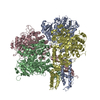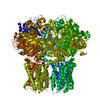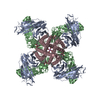+ Open data
Open data
- Basic information
Basic information
| Entry | Database: PDB / ID: 6nd0 | ||||||
|---|---|---|---|---|---|---|---|
| Title | human BK channel reconstituted into liposomes | ||||||
 Components Components | Calcium-activated potassium channel subunit alpha-1 | ||||||
 Keywords Keywords | MEMBRANE PROTEIN / the large conductance voltage- and calcium-activated potassium (BK) channel / Ca2+ sensor / gating ring / random spherically constrained (RSC) single-particle cryo-EM | ||||||
| Function / homology |  Function and homology information Function and homology informationAcetylcholine inhibits contraction of outer hair cells / micturition / large conductance calcium-activated potassium channel activity / Ca2+ activated K+ channels / calcium-activated potassium channel activity / negative regulation of cell volume / smooth muscle contraction involved in micturition / response to carbon monoxide / response to osmotic stress / Sensory processing of sound by inner hair cells of the cochlea ...Acetylcholine inhibits contraction of outer hair cells / micturition / large conductance calcium-activated potassium channel activity / Ca2+ activated K+ channels / calcium-activated potassium channel activity / negative regulation of cell volume / smooth muscle contraction involved in micturition / response to carbon monoxide / response to osmotic stress / Sensory processing of sound by inner hair cells of the cochlea / cGMP effects / intracellular potassium ion homeostasis / voltage-gated potassium channel activity / voltage-gated potassium channel complex / potassium ion transmembrane transport / regulation of membrane potential / response to calcium ion / caveola / potassium ion transport / vasodilation / actin binding / postsynaptic membrane / response to hypoxia / positive regulation of apoptotic process / apical plasma membrane / metal ion binding / identical protein binding / membrane / plasma membrane Similarity search - Function | ||||||
| Biological species |  Homo sapiens (human) Homo sapiens (human) | ||||||
| Method | ELECTRON MICROSCOPY / single particle reconstruction / cryo EM / Resolution: 3.5 Å | ||||||
 Authors Authors | Wang, L. / Tonggu, L. | ||||||
| Funding support |  United States, 1items United States, 1items
| ||||||
 Citation Citation |  Journal: To Be Published Journal: To Be PublishedTitle: Broken symmetry in the human BK channel Authors: Tonggu, L. / Wang, L. | ||||||
| History |
|
- Structure visualization
Structure visualization
| Movie |
 Movie viewer Movie viewer |
|---|---|
| Structure viewer | Molecule:  Molmil Molmil Jmol/JSmol Jmol/JSmol |
- Downloads & links
Downloads & links
- Download
Download
| PDBx/mmCIF format |  6nd0.cif.gz 6nd0.cif.gz | 519.6 KB | Display |  PDBx/mmCIF format PDBx/mmCIF format |
|---|---|---|---|---|
| PDB format |  pdb6nd0.ent.gz pdb6nd0.ent.gz | 414.5 KB | Display |  PDB format PDB format |
| PDBx/mmJSON format |  6nd0.json.gz 6nd0.json.gz | Tree view |  PDBx/mmJSON format PDBx/mmJSON format | |
| Others |  Other downloads Other downloads |
-Validation report
| Summary document |  6nd0_validation.pdf.gz 6nd0_validation.pdf.gz | 1 MB | Display |  wwPDB validaton report wwPDB validaton report |
|---|---|---|---|---|
| Full document |  6nd0_full_validation.pdf.gz 6nd0_full_validation.pdf.gz | 1 MB | Display | |
| Data in XML |  6nd0_validation.xml.gz 6nd0_validation.xml.gz | 79.4 KB | Display | |
| Data in CIF |  6nd0_validation.cif.gz 6nd0_validation.cif.gz | 121.3 KB | Display | |
| Arichive directory |  https://data.pdbj.org/pub/pdb/validation_reports/nd/6nd0 https://data.pdbj.org/pub/pdb/validation_reports/nd/6nd0 ftp://data.pdbj.org/pub/pdb/validation_reports/nd/6nd0 ftp://data.pdbj.org/pub/pdb/validation_reports/nd/6nd0 | HTTPS FTP |
-Related structure data
| Related structure data |  0439MC M: map data used to model this data C: citing same article ( |
|---|---|
| Similar structure data |
- Links
Links
- Assembly
Assembly
| Deposited unit | 
|
|---|---|
| 1 |
|
- Components
Components
| #1: Protein | Mass: 99256.867 Da / Num. of mol.: 4 Source method: isolated from a genetically manipulated source Source: (gene. exp.)  Homo sapiens (human) / Gene: KCNMA1, KCNMA, SLO / Cell line (production host): HEK293 / Production host: Homo sapiens (human) / Gene: KCNMA1, KCNMA, SLO / Cell line (production host): HEK293 / Production host:  Homo sapiens (human) / References: UniProt: Q12791 Homo sapiens (human) / References: UniProt: Q12791 |
|---|
-Experimental details
-Experiment
| Experiment | Method: ELECTRON MICROSCOPY |
|---|---|
| EM experiment | Aggregation state: PARTICLE / 3D reconstruction method: single particle reconstruction |
- Sample preparation
Sample preparation
| Component | Name: human BK channel reconstituted into liposomes / Type: COMPLEX / Entity ID: all / Source: RECOMBINANT | ||||||||||||||||||||
|---|---|---|---|---|---|---|---|---|---|---|---|---|---|---|---|---|---|---|---|---|---|
| Molecular weight | Value: 0.5 MDa / Experimental value: NO | ||||||||||||||||||||
| Source (natural) | Organism:  Homo sapiens (human) Homo sapiens (human) | ||||||||||||||||||||
| Source (recombinant) | Organism:  Homo sapiens (human) Homo sapiens (human) | ||||||||||||||||||||
| Buffer solution | pH: 7.3 | ||||||||||||||||||||
| Buffer component |
| ||||||||||||||||||||
| Specimen | Conc.: 1 mg/ml / Embedding applied: NO / Shadowing applied: NO / Staining applied: NO / Vitrification applied: YES Details: Swelled BK proteoliposomes yielded a concentration of 2 mM lipid and 1mg/ml protein. | ||||||||||||||||||||
| Specimen support | Grid material: COPPER / Grid mesh size: 400 divisions/in. / Grid type: C-flat-2/2 | ||||||||||||||||||||
| Vitrification | Instrument: FEI VITROBOT MARK IV / Cryogen name: ETHANE / Humidity: 100 % / Chamber temperature: 295 K Details: BK proteoliposomes were applied onto a glow-discharged perforated carbon grid (CFlat R2/2, EMS), and incubated for 5-10 min In an FEI Vitrobot Mark IV (FEI). After incubation, the sample was ...Details: BK proteoliposomes were applied onto a glow-discharged perforated carbon grid (CFlat R2/2, EMS), and incubated for 5-10 min In an FEI Vitrobot Mark IV (FEI). After incubation, the sample was blotted from the side and buffer containing 10 mM HEPES, pH 7.3, 75 mM KCl, and 1 mM EDTA was applied onto the TEM grid to further swell proteoliposomes. Then grids were blotted for 7 s with force 0 and fast frozen in liquid ethane cooled by liquid nitrogen. |
- Electron microscopy imaging
Electron microscopy imaging
| Experimental equipment |  Model: Titan Krios / Image courtesy: FEI Company |
|---|---|
| Microscopy | Model: FEI TITAN KRIOS Details: The Coma free alignment was performed using Auto-CTF software from FEI. |
| Electron gun | Electron source:  FIELD EMISSION GUN / Accelerating voltage: 300 kV / Illumination mode: FLOOD BEAM FIELD EMISSION GUN / Accelerating voltage: 300 kV / Illumination mode: FLOOD BEAM |
| Electron lens | Mode: BRIGHT FIELD / Nominal magnification: 130000 X / Nominal defocus max: 4000 nm / Nominal defocus min: 852 nm / Cs: 2.7 mm / C2 aperture diameter: 50 µm / Alignment procedure: COMA FREE |
| Specimen holder | Cryogen: NITROGEN / Specimen holder model: FEI TITAN KRIOS AUTOGRID HOLDER / Temperature (max): 103.5 K / Temperature (min): 90.8 K |
| Image recording | Average exposure time: 8.6 sec. / Electron dose: 60 e/Å2 / Detector mode: SUPER-RESOLUTION / Film or detector model: GATAN K2 SUMMIT (4k x 4k) / Num. of grids imaged: 3 / Num. of real images: 3089 Details: Images were recorded in an automated fashion on a Gatan K2 Summit (Gatan) detector set to super-resolution mode with a super-resolution pixel size of 0.525 A using Leginon. The dose rate on ...Details: Images were recorded in an automated fashion on a Gatan K2 Summit (Gatan) detector set to super-resolution mode with a super-resolution pixel size of 0.525 A using Leginon. The dose rate on the camera was set to be ~8 counts per physical pixel per second. The total exposure time was 8.6 s (0.2 s/frame), leading to a total accumulate dose of 60 electrons per A2 on the specimen. |
| EM imaging optics | Energyfilter name: GIF Bioquantum / Energyfilter slit width: 20 eV |
| Image scans | Width: 3838 / Height: 3710 / Movie frames/image: 43 / Used frames/image: 1-43 |
- Processing
Processing
| Software | Name: PHENIX / Version: 1.13_2998: / Classification: refinement | ||||||||||||||||||||||||||||||||||||||||||||||||||
|---|---|---|---|---|---|---|---|---|---|---|---|---|---|---|---|---|---|---|---|---|---|---|---|---|---|---|---|---|---|---|---|---|---|---|---|---|---|---|---|---|---|---|---|---|---|---|---|---|---|---|---|
| EM software |
| ||||||||||||||||||||||||||||||||||||||||||||||||||
| Image processing | Details: Dose-fractionated super-resolution image stacks were motion-corrected with MotionCorr2. Each frame in the image stack was divided into 5x5 patches for anisotropic image motion correction and ...Details: Dose-fractionated super-resolution image stacks were motion-corrected with MotionCorr2. Each frame in the image stack was divided into 5x5 patches for anisotropic image motion correction and dose weighting was carried out to calculate the motion-corrected image. | ||||||||||||||||||||||||||||||||||||||||||||||||||
| CTF correction | Details: CTF full correction was performed following RELION 3D reconstruction Type: PHASE FLIPPING AND AMPLITUDE CORRECTION | ||||||||||||||||||||||||||||||||||||||||||||||||||
| Particle selection | Num. of particles selected: 275295 Details: Approximately 4,800 particles from 350 micrographs were interactively selected and classified using RELION. Ten representative classes were selected as the templates for automated particle ...Details: Approximately 4,800 particles from 350 micrographs were interactively selected and classified using RELION. Ten representative classes were selected as the templates for automated particle picking using RELION. The automated picked particles were screened using homemade MATLAB (MathWorks) programs to exclude particles more than 80 A away from any liposome, which resulted in 275,295 particles from 2,786 micrographs. | ||||||||||||||||||||||||||||||||||||||||||||||||||
| Symmetry | Point symmetry: C2 (2 fold cyclic) | ||||||||||||||||||||||||||||||||||||||||||||||||||
| 3D reconstruction | Resolution: 3.5 Å / Resolution method: FSC 0.143 CUT-OFF / Num. of particles: 122456 / Symmetry type: POINT | ||||||||||||||||||||||||||||||||||||||||||||||||||
| Atomic model building | Protocol: FLEXIBLE FIT / Space: REAL |
 Movie
Movie Controller
Controller









 PDBj
PDBj


